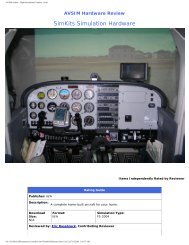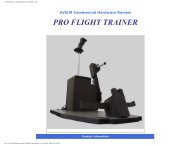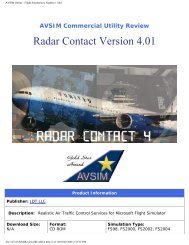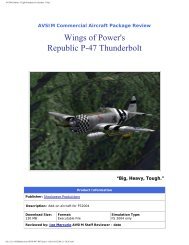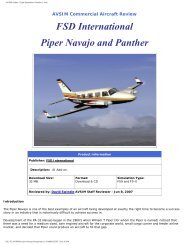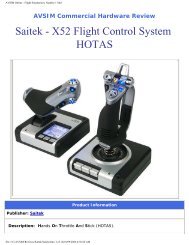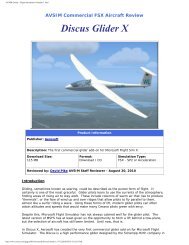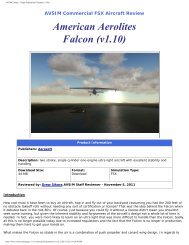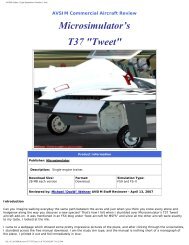Concorde-X - Avsim
Concorde-X - Avsim
Concorde-X - Avsim
You also want an ePaper? Increase the reach of your titles
YUMPU automatically turns print PDFs into web optimized ePapers that Google loves.
AVSIM Online - Flight Simulation's Number 1 Site!<br />
no idea how it should fly, but I think I can compare this aircraft with other sophisticated add-on models like the PMDG 747, MD-<br />
11 and the Leonardo SH MD80 Maddog. One thing is for sure, and that's the same with the previous models as well, it’s not an<br />
airplane where you quickly do the refueling, add some payload and start the engines etc.<br />
According to the tutorial and the settings I made, we're heading for an initial altitude of FL260. During this climb and the<br />
necessary settings I made, I can tell you that switching knobs, switches and whatever else, offers a realistic sound. Let's give you<br />
an example; when you set at the AFCP (Auto flight Control Panel) to a new altitude and you close your eyes while selecting the<br />
knob, it gives you the feeling you're in the real <strong>Concorde</strong>. You can hear the gears inside the panel turning. This is only one sound<br />
example, but there are many more.<br />
In the meantime our <strong>Concorde</strong>-X accelerates to a VMO of 400 knots and don't forget, we'll still flying subsonic. Later on during<br />
our flight we will move from transonic to supersonic sound. Although not real, this is indeed impressive, since this is something<br />
you won't find from any other commercial passenger aircraft.<br />
During our climb and speed changes it's a good moment to study the tutorial in advance where possible. Flying supersonic is not<br />
something each flight simmer will do on a daily base, therefore I'm happy with the tutorial since it gives a very thorough<br />
description of supersonic steps to follow. Not directly related to it, it seems that the tutorial is a reflection of the checklist sections<br />
and therefore each section is short, informative, easy to understand and makes the aircraft easy to handle. There's also an option<br />
that we know from PMDG models and that's saving flight situations. Anyway, let’s continue with our supersonic approach.<br />
Approaching supersonic conditions is something unique even though it's FSX. It’s really awesome and requires close monitoring<br />
of the instruments since before you know it, you have passed Mach 1.0. Yes I'm aware that this aircraft can fly a little faster than<br />
Mach 1.0, but even passing this mark is extraordinary. A little later during the flight we've reached Mach 2.01 at an altitude of<br />
approximately 50,000 feet.<br />
What makes this speed and altitudes so special? Speed is something you can see on your instruments as well as in the virtual<br />
cabin, but what about the altitude. This is more or less the same, but looking outside, that makes the difference; the sky is deep<br />
blue, no, it's almost black. This is something you won't see when flying subsonic or at a maximum altitude of 42,000 feet. If<br />
you’re curious, have a look to the following screenshots.<br />
http://www.avsim.com/pages/0111/FltSimLab/SST.html (12 of 17)11/01/2011 5:08:54 PM



